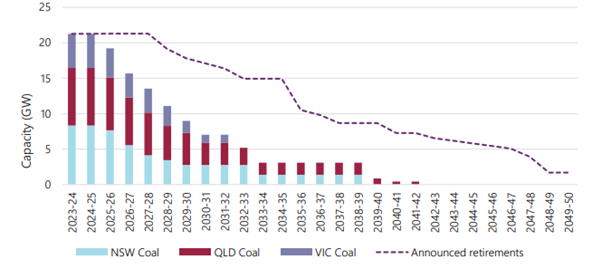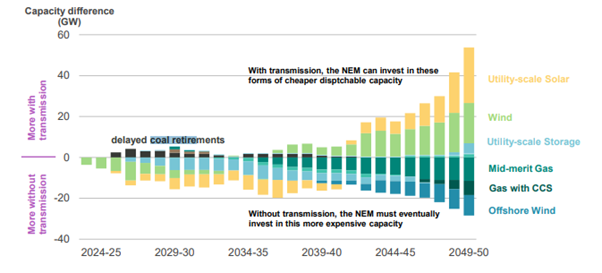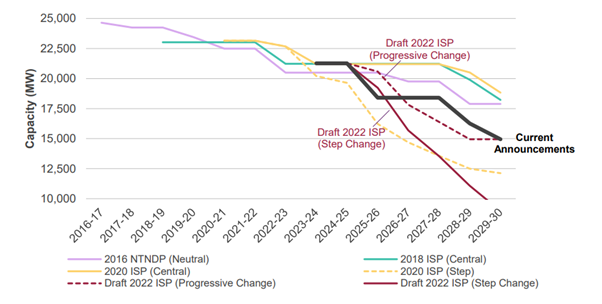As one generation ends another begins
The Australian Energy Market Operator (AEMO) released the draft 2022 Integrated System Plan (ISP) in December 2021. At the time Energy Networks Australia was quick to note the importance of transmission as the backbone of Australia’s energy grid and an enabler of a lower emissions future in our February 2022article on the draft ISP.[1]
The National Energy Rules require the Australian Energy Regulator (AER) to undertake two transparency reviews as the ISP is developed. The AER has already reviewed the inputs and assumptions determined by AEMO in developing the ISP to ensure there is greater confidence in the plan. The AER must also assess the development of the ISP to ensure that AEMO’s processes are credible, transparent and robust. The AER issued its findings on its review of the draft 2022 ISP in January 2022 and AEMO responded to the AER’s findings in March.
In the draft ISP report the AER challenged that AEMO had not provided sufficient explanation on several matters regarding earlier coal retirements:
- The draft ISP does not detail how the inputs and assumptions have contributed to the assessment of profitability of coal plants and revenue adequacy that may lead to earlier retirements;
- Why coal plants are not assumed to operate more flexibly intra-day; and
- What supports the conclusion that seasonal mothballing will not extend coal plant life.
What did the draft 2022 ISP say regarding plant retirements?
Fig 1 Forecast coal retirements, step change technology and regional outlook[2]
Then February 2022 happened and several announcements later…
The writing had been on the wall for almost a decade but in February 2022, Gentailor Origin flagged to the ASX the potential for closure of NSW’s Eraring power station in 2025, seven years earlier than planned;
‘Notice has been submitted to the Australian Energy Market Operator (AEMO) indicating the potential early retirement of Eraring power station at the end of the required three-and-a-half-year notice period. This reflects the rapidly changing conditions in the National Electricity Market (NEM), which are increasingly not well suited to traditional baseload power stations and challenging their viability.’[3]
As more solar and wind connects in the NEM it changes the needs of baseload power. Origin noted that the rapid transition to renewables is putting pressure on the economics of coal plant. When the sun is shining and the wind is blowing, renewables can lower the wholesale price of electricity and reduce demand for base load power. When there is no sun or wind, then dispatchable firm generation is required to meet demand. This dispatchable energy comes from coal plant, hydro electricity, gas plant or batteries.
AGL made a similar announcement for its Bayswater power plant.
The Reliability Panel also highlighted the expected coal closures dates in its recent market report:[4]
- Liddell unit 3 closure was brought forward to 2022 from 2023 and Liddell unit 4 closure was pushed out to 2023 from 2022
- Loy Yang A closure was brought forward to 2045 from 2048
- Eraring closure was brought forward to 2025 from 2032
- Bayswater closure was brought forward to 2033 from 2035.
There are also several notable gas generator closures expected in South Australia:
- Torrens Island A unit 3, which is due to close in September 2022
- Osborne, which is due to close in December 2023.
The draft 2022 ISP notes that firming capacity requirements will treble as coal retires to ensure that there is sufficient supply to meet demand.
New and upgraded transmission will also be essential to connect the renewable generation that is built to replace traditional plant. The draft 2022 ISP contrasts the system requirements with and without new transmission. Without transmission, there is a higher use of gas and offshore wind in the mix, reducing the net benefits for consumers of the integrated plan.
Fig 2 Differences in capacity needed in Step change, with and without new network[5]
The heated political leaders debate held earlier this week indicates the importance of transmission as an enabler of the move to a lower emissions economy.[6] It is important the right transmission projects proceed that deliver genuine benefit for consumers and that these projects are delivered in time. Energy affordability is a real concern, an appropriate integrated plan and regulatory oversight are key to ensure the total system costs are in the long-term interests of consumers.
AEMO’s response to AERs findings
AEMO in its response to the AER’s findings noted that the 2020 step change and the draft 2022 ISP step change seem broadly aligned with the current closure announcements. AEMO rightly notes that coal closures are challenging to predict and deal with a range of uncertainties.
Fig 3 AEMO’s forecast coal retirements and the current announced retirement schedule, 2016-17 to 2029-30[7]
AEMO sought input from generators on the ability to moth ball plants for short periods or seasons, which could lead to plant being delayed in its return to service after maintenance.
AEMO also considered with coal generators the ability to ramp up/down intraday within the technical limits of plant. This could result in behavior where plant operations turn off coal plant on sunny/windy days and turn it back on for event peak. This would increase the plant ramping required and will likely negatively impact the cost and operational wear and tear of plant.
What is clear is the transition is happening faster than expected. Reliability and system security need to be managed through this transition. It is important that the essential system services are available to help manage the system as the increased levels of roof top PV and small-scale DER continue to decrease the minimum demand in each state, resulting in the need for more operational levers for system security.
Where the wholesale price used to have these services implicit in the spot price, in a renewable future, as the wholesale price reduces reflecting the lower cost of renewables, alternate system services will need to be procured. At least for the short-term synchronous generation, afforded by coal, gas and hydro generators, has a vital role to ensure a resilient power grid.
[1] https://www.energynetworks.com.au/news/energy-insider/2022-energy-insider/transmission-the-backbone-of-our-energy-grid/
[2] AEMO Draft 2022 ISP, p46
[3] ASX media release Origin, 17 Feb 22 https://company-announcements.afr.com/asx/org/32227ad3-8f6e-11ec-b43c-b28af01120e0.pdf
[4] Reliability Panel AEMC Final report, 2021 Annual Market Performance Report, April 22
[5] AEMO Draft 2022 ISP, p59
[6] Leaders debate link from Sunday
[7] AEMO Addendum to Draft 2022 ISP, March 2022, p7






